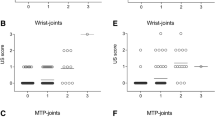Abstract
Background
There is sparse knowledge about grading tenosynovitis using MRI.
Objective
The purpose of this study was to assess the reliability of a tenosynovitis MRI scoring system in juvenile idiopathic arthritis.
Materials and methods
Children with juvenile idiopathic arthritis and wrist involvement were enrolled in two paediatric centres, from October 2006 to January 2010. The extensor (compartments II, IV and VI) and flexor tendons were assessed for the presence of tenosynovitis on T1-weighted postcontrast fat-saturated MR images and were scored from 0 (normal) to 2 (moderate to severe) by two observers independently. Intra- and interobserver agreement was assessed.
Results
Ninety children (age range: 5–18.5 years) were included, of whom 34 had tenosynovitis involving extensors and 28 had tenosynovitis involving flexors. A total of 360 tendon areas were analysed, of which 114 had tenosynovitis (86/270 extensors and 28/90 flexors). Intra-reader 1 agreement was excellent for the extensors (k = 0.82–0.91) and for the flexors (k = 0.85); intra-reader 2 agreement was moderate to good for the extensors (k = 0.51–0.72) and good for the flexors (k = 0.64). Inter-reader agreement was good for the extensors (k = 0.69–0.73) and moderate for the flexors (k = 0.49).
Conclusion
The proposed MRI scoring system for the assessment of wrist tenosynovitis in juvenile idiopathic arthritis appears feasible with an observer agreement sufficient for clinical use.





Similar content being viewed by others
References
Graham TB, Laor T, Dardzinski BJ (2005) Quantitative magnetic resonance imaging of the hands and wrists of children with juvenile rheumatoid arthritis. J Rheumatol 32:1811–1820
Malattia C, Damasio MB, Pistorio A et al (2011) Development and preliminary validation of a paediatric-targeted MRI scoring system for the assessment of disease activity and damage in juvenile idiopathic arthritis. Ann Rheum Dis 70:440–446
Østergaard M, Peterfy C, Conaghan P et al (2003) OMERACT rheumatoid arthritis magnetic resonance imaging studies. Core set of MRI acquisitions, joint pathology definitions, and the OMERACT RA-MRI scoring system. J Rheumatol 30:1385–1386
Haavardsholm EA, Østergaard M, Ejbjerg BJ et al (2007) Introduction of a novel magnetic resonance imaging tenosynovitis score for rheumatoid arthritis: reliability in a multireader longitudinal study. Ann Rheum Dis 66:1216–1220
Cohen J (1960) A coefficient of agreement for nominal scales. Educ Psychol Meas 20:37–46
Landis R, Koch G (1977) The measurement of observer agreement for categorical data. Biometrics 33:159–174
Shrout PE, Fleiss JL (1979) Intraclass correlations: uses in assessing rater reliability. Psychol Bull 86:420–428
Bland JM, Altman DG (1986) Statistical methods for assessing agreement between two methods of clinical measurements. Lancet 8476:307–310
Østergaard M, Klarlund M (2001) Importance of timing of post-contrast MRI in rheumatoid arthritis: what happens during the first 60 minutes after IV gadolinium-DTPA? Ann Rheum Dis 60:1050–1054
Østergaard M (1999) Magnetic resonance imaging in rheumatoid arthritis. Quantitative methods for assessment of the inflammatory process in peripheral joints (doctoral thesis). Dan Med Bull 46:313–344
Rooney ME, McAllister C, Burns JF (2009) Ankle disease in juvenile idiopathic arthritis: ultrasound findings in clinically swollen ankles. J Rheumatol 36:1725–1729
Pascoli L, Wright S, McAllister C et al (2010) Prospective evaluation of clinical and ultrasound findings in ankle disease in juvenile idiopathic arthritis: importance of ankle ultrasound. J Rheumatol 37:2409–2414
Karmazyn B, Bowyer SL, Schmidt KM et al (2007) US findings of metacarpophalangeal joints in children with idiopathic juvenile arthritis. Pediatr Radiol 37:475–482
Wakefield RJ, O’Connor PJ, Conaghan PG et al (2007) Finger tendon disease in untreated early rheumatoid arthritis: a comparison of ultrasound and magnetic resonance imaging. Arthritis Rheum 57:1158–1164
Boutry N, Lardé A, Lapègue F et al (2003) Magnetic resonance imaging appearance of the hands and feet in patients with early rheumatoid arthritis. J Rheumatol 30:671–679
Klarlund M, Ostergaard M, Jensen KE et al (2000) Magnetic resonance imaging, radiography, and scintigraphy of the finger joints: one year follow up of patients with early arthritis. The TIRA Group. Ann Rheum Dis 59:521–528
Eshed I, Feist E, Althoff CE et al (2009) Tenosynovitis of the flexor tendons of the hand detected by MRI: an early indicator of rheumatoid arthritis. Rheumatology (Oxford) 48:887–891
Lisbona MP, Maymó J, Perich J et al (2010) Rapid reduction in tenosynovitis of the wrist and fingers evaluated by MRI in patients with rheumatoid arthritis after treatment with etanercept. Ann Rheum Dis 69:1117–1122
Engesæter IØ, Laborie LB, Lehmann TG et al (2012) Radiological findings for hip dysplasia at skeletal maturity. Validation of digital and manual measurement techniques. Skeletal Radiol 41:775–785
Malattia C, Damasio MB, Basso C et al (2012) A novel automated system for MRI quantification of the inflamed synovial membrane volume in patients with juvenile idiopathic arthritis. Arthritis Care Res (Hoboken) 64:1657–1664. doi:10.1002/acr.21739
Author information
Authors and Affiliations
Corresponding author
Rights and permissions
About this article
Cite this article
Lambot, K., Boavida, P., Damasio, M.B. et al. MRI assessment of tenosynovitis in children with juvenile idiopathic arthritis: inter- and intra-observer variability. Pediatr Radiol 43, 796–802 (2013). https://doi.org/10.1007/s00247-012-2613-x
Received:
Revised:
Accepted:
Published:
Issue Date:
DOI: https://doi.org/10.1007/s00247-012-2613-x




